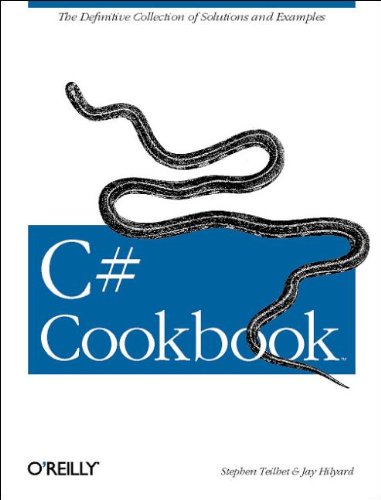Articoli correlati a C# Cookbook

Easy to learn and use, the C# language is targeted at developers for Microsoft's .NET platform who've worked with a C-like language before, such as C, C++, or Java. There's no shortage of excellent tutorials and documentation to help new developers get a handle on the language, such as O'Reilly's Learning C# or Programming C#. But when you need practical answers to the day-to-day questions you run up against, a tutorial isn't going to do the trick. The C# Cookbook gets straight to the heart of the problem with code recipes collected especially for developers working on the .NET platform.The C# Cookbook offers a definitive collection of solutions and examples for this new programming language. Recipes range from simple tasks to the more complex, and are organized with respect to the types of problems you'll need to solve as you progress in your experience as a C# programmer. Nearly every recipe contains a complete, documented code sample showing you how to solve the specific problem, as well as a discussion of how the underlying technology works and a discussion of alternatives, limitations, and other considerations where appropriate.The recipes in the C# Cookbook are organized into seventeen chapters, each of which focuses on a particular topic in creating C# solutions. Among the topics covered, you'll find:
- Numeric data types in C#
- Strings and characters
- Classes and structures
- Exception handling
- Delegates and events
- Regular expressions
- Data structures and algorithms
- Networking
- Security
- Unsafe Code
Le informazioni nella sezione "Riassunto" possono far riferimento a edizioni diverse di questo titolo.
Stephen Teilhet earned a degree in electrical engineering but soon afterwards began writing software for the Windows platform. For the last eight years, he has worked for several consulting firms on a wide range of projects, specializing in Visual Basic, Visual C++, MTS, COM, MSMQ, and SQL Server. Stephen currently works for Compuware Numega Labs in Nashua, New Hampshire, where he is immersed in the Microsoft .NET technologies.
Jay Hilyard has been developing applications for the Windows platform for over 10 years and is currently a .NET enthusiast. Jay has published an article in MSDN Magazine on Profiling and Garbage Collection and he currently works on the BoundsChecker team at the Compuware NuMega Lab in Nashua, NH. When not immersed in .NET, Jay spends his time with his family and rooting for the Patriots.
Le informazioni nella sezione "Su questo libro" possono far riferimento a edizioni diverse di questo titolo.
- EditoreO'Reilly Media
- Data di pubblicazione2004
- ISBN 10 0596003390
- ISBN 13 9780596003395
- RilegaturaCopertina flessibile
- Numero di pagine840
- Valutazione libreria
Compra nuovo
Scopri di più su questo articolo
Spese di spedizione:
EUR 5,75
In U.S.A.
I migliori risultati di ricerca su AbeBooks
C# COOKBOOK
Descrizione libro Condizione: New. New. In shrink wrap. Looks like an interesting title! 2.7. Codice articolo Q-0596003390

